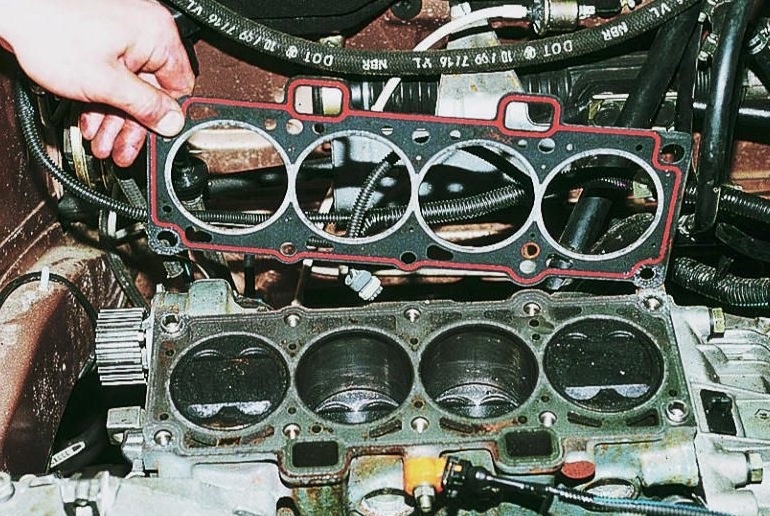
what is it in the car - decoding of the abbreviation and photo
Content
In the design of the engine, each part performs a specific function. Regardless of whether it is a connecting rod, a piston pin or a crankshaft oil seal, a part breakdown leads to serious consequences. One of the important elements is the gasket Cylinder head - cylinder head... Why is it needed and what does its wear and tear threaten? What are the signs that the cylinder head gasket is broken? We will consider these questions in today's article on vodi.su.
Cylinder head gasket: what is it
An internal combustion engine consists of two main parts: the cylinder block and the cylinder head. The head closes the combustion chambers, the valves and the valve mechanism are mounted in it, and it is also in it that the camshafts are installed. From above, it is closed by a valve block cover. The cylinder head gasket, as you might guess, is located between the cylinder block and the head.

If the engine is 4-cylinder, then in the gasket we see four large circular cutouts, as well as holes for the bolts with which the head is attached to the block, and for channels for the circulation of process fluids. The main material for its production is reinforced paronite, and the holes for the combustion chambers have a metal edging. It can be made of thin sheet metal. There are other options: copper, multilayer metal-elastomer composition, asbestos-graphite.
Immediately, we note that the cylinder head gasket itself is not expensive. The replacement work is much more expensive, since you have to disassemble the engine, and after replacement, adjust the timing mechanism and gas distribution. What functions does this gasket perform:
- sealing of combustion chambers;
- prevention of gas leakage from the engine;
- prevention of oil and coolant leakage;
- prevents coolant and engine oil from mixing.
But since asbestos gaskets are installed on most modern cars, they simply burn out over time, which creates a serious precedent - gases from combustion chambers can enter the cooling circuits, and coolant seeps into the engine. Why it is dangerous: the oil film is washed off the cylinder walls, their accelerated wear occurs, the power unit does not cool properly, the possibility of pistons jamming.
How to understand that the cylinder head gasket is broken?
If a cylinder head gasket needs to be replaced, you will quickly know about it by a number of characteristic signs. The most obvious of them is blue smoke from the exhaust pipe, similar to steam. This means that antifreeze or antifreeze is actively seeping into the block. Other typical symptoms of a blown cylinder head gasket:
- overheating of the engine;
- gases enter the cooling jacket, while the antifreeze begins to boil in the expansion tank;
- problems when starting the engine - due to a burned-out gasket, gases from one chamber enter another;
- oily drips at the junction of the cylinder head and the cylinder block.

You can notice that the oil is mixed with antifreeze when checking the level - traces of white foam will be visible on the dipstick. Oil stains are visible in the coolant reservoir with the naked eye. If antifreeze and grease are mixed, you will have to change the gasket, flush the engine cooling system, change the oil.
The problem is that the break of the gasket does not occur immediately. The hole expands gradually due to engine stress, high compression, improper installation, or the use of inexpensive materials. Detonations, which we recently talked about on vodi.su, also lead to wear on the cylinder head gasket.
Please note: manufacturers do not indicate specific terms when it is necessary to change this sealing element. Therefore, with each passage of MOT, it is necessary to diagnose the power unit for oil and coolant leaks.
Replacing the cylinder head gasket
If you notice at least one of the above signs, you need to replace the cylinder head gasket. It is better to order the service at professional service stations, where the necessary tools are available. The process of removing the “head” itself is quite complicated, since it will be necessary to disconnect the mass of sensors, attachments, a timing belt or chain. In addition, the cylinder head bolts are tightened with a torque wrench. There are special schemes for how to unscrew and tighten them correctly. For example, to dismantle the head, you need to turn all the bolts one by one, starting from the middle, one time to relieve stress.

After the cylinder head is dismantled, the location of the old gasket is thoroughly cleaned and degreased. The new one is laid on the sealant so that it just sits in place. The tightening of the bolts must be carried out strictly according to the scheme with the optimal tightening torque. By the way, in most cases, these bolts need to be changed. After completion of work, the driver monitors the behavior of the motor. The absence of overheating, traces of oil, etc. is evidence of a correctly performed replacement.
Loading…